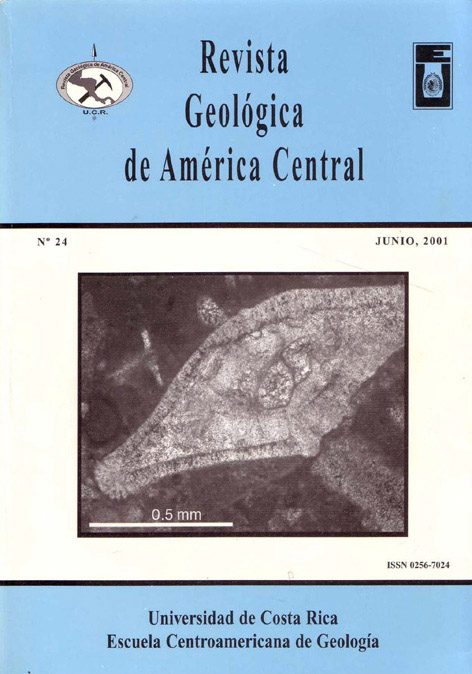Abstract
In this preliminary paper we report on age, microfacies, microfossils and structural setting of platformlimestones, that crop out in the Río Tempisque area (Guanacaste, Costa Rica). The limestones can be attributed to twodistinct carbonate platform systems: 1. The El Viejo Platform, dated as late Campanian – Maastrichtian, which is rep-resented by slope facies in the Cerros Ballena and Cebollín (near Filadelfia, Peninsula de Nicoya). 2. The Barra HondaPlatform, of Upper Paleocene – Lower Eocene age, that extends from the classical outcrops at Cerro Barra Honda inthe South, to the Palo Verde region in the North.At Cerro Cebollín, carbonate-rich turbitites and mass flow deposits rest unconformably on basalts of the NicoyaComplex s. str. Pelagic limestone clasts with planktonic foraminifera, and abundant rudist fragments document a lateCampanian - Maastrichtian age of the sequence. Basalt and serpentinite lithoclasts witness erosion of an oceanic base-ment, such as the Santa Elena Ultramafic Unit. The Cerro Cebollín sequence is interpreted as a slope deposit thatreceived abundant material form shallow carbonate platforms of the El Viejo Formation that crops out in the northernNicoya and Santa Elena Peninsulas.At Cerro Barra Honda, Cerro Quebrada Honda and other classical outcrops of the Barra Honda Formation microfa-cies range from restricted to open marine. Most facies contain Ethelia alba a Squamariacean algae reported for thefirst time from Central America. Restricted micritic facies from Lomas las Pozas contain Thalmannita madrugaensis,a Rotaliid foraminifer, so far only known from the Paleocene of Cuba. In the Palo Verde area to the North, typicalBarra Honda facies pass into high energy, open platform facies characterized by abundant red algae and largerforaminifera ranging from Late Paleocene to Early Eocene. Planktonic foraminifera such as Morozovella velascoensis allow to restrict the base of Barra Honda to the latest Paleocene.In general, the Barra Honda Platform rests unconformably on deformed Late Cretaceous-Paleocene deep-water sedi-ments. Its basal onsett is transgressive over subaerially altered rocks (Espíritu Santo) or progradational over openmarine Late Paleocene sediments (Pochote). Reworked Late Cretaceous lithoclasts testify for lithification and (tec-tonic) exposure of the underlying rocks.To the East of the Tempisque River, in the area of the Cerro Naranjo the emplacement of Barra Honda over intense-ly deformed detrital formations as young as middle Eocene may be attributed to gravity tectonics and/or a transpres-sive setting along longitudinal strike-slip faults that have been postulated along the Tempisque River.Comments
Downloads
Download data is not yet available.






